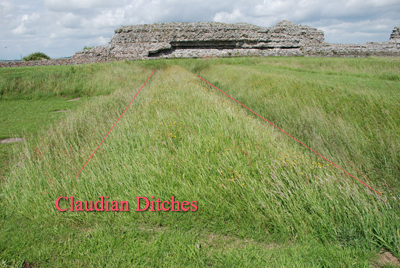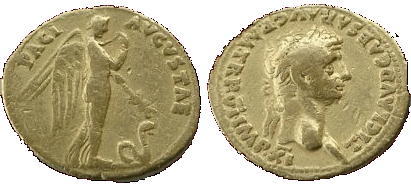CLAUDIAN
INVASION
(a change in government?)
AD 41-54 Claudius
Trace the invasion ok Kent. did anyone put up a fight?
Caesar brought with him two legions for his invasion of Britain and some 800 boats. Claudius brought four legions and goodness know how many boats, probably more than 2000. Where Claudius disembarked and the reason his landing was unopposed is still debated but the belief is that it was near Richborough where there was a natural harbour and the River Stour runs into mudflats, marsh and then sea; and that the Britons were expecting an invasion but got tired of waiting and dispersed. The reason for the delay was a mutiny by the Roman soldiers; they had mutinied in the past under Gaius and were now again unruly and unready to cross the 'Ocean' fearing the unknown. Whatever the reason the attack was delayed, perhaps until May of 43AD, before three divisions (in three waves?) left Boulogne. Whether the expedition landed in three places (i.e. Dover, Lympne or West Sussex) is still disputed but largely dismissed; what general would split his men and land on three different beachheads miles apart? Claudius knew from Caesar's debacles that he needed to harbour his ships and Richborough was a likely place. The mutiny had delayed the sailing of the fleet, the landing was unopposed at Richborough although the Britons knew of the plan to invade. Early Claudian defensive ditches are still in evidence at Richborough (Rutipiae) on the site of the fort.
Although the landing went ahead with apparent ease Claudius could find no enemy to fight although there were two skirmishes in East Kent as Aulus Plautius led his men to Camulodunum, the 'capital'. Where they battled in East Kent is not known but the Celtic leaders of the contacts were Togodumnus and Caratacus ( both sons of Cunobelin). These two were easily beaten and they retreated to the Medway where they re-grouped en masse, perhaps thousands, to oppose a crossing of the Medway by the invaders. The route from Richborough onward is again unknown but it seems likely Plautius first made his way to Canterbury where there was a large Belgic settlement and where he is said to have built a marching fort at Harbledown (near Bigbury). The route to the Medway is likely to have been the ancient trackway which was to become the Watling Street. It has been suggested (and dismissed) that a Roman Fort of Claudian times is in evidence in the Faversham/Ospringe area and this is of course beside the ancient trackway.
The Britons were amassed, waiting, at a Medway crossing - this is where the decisive battle of Britain was to take place. The site is believed to be not at Aylesford but beneath Rochester where a Belgic settlement was located (with its own mint), perhaps near the siting of the M2 motorway bridge. The Britons were confident that they would hold the crossing but Plautius had a group of special auxiliary troops (Batavi) trained in swimming with full gear. While others of Plautius' men diverted the Britons somehow, the Batavi swam the Medway and killed the Britons' horses so they were unable to use their chariots. It was a hard fight involving Vespasian, his brother Sabinus and one Geta who distinguished himself. The battle unusually spanned two days but eventually the Britons were routed and fell back to the Thames or Essex. Plautius followed.
Crossing the Thames again called for the expertise of the special auxiliaries. The crossing place is unknown but may be the 'Pool of London'. While they found their way across, one other detachment of men found a bridge downstream and crossed the river there (at Thorney Island, Westminster?). The Britons north of the Thames were thus attacked from two sides in a pincer movement, apparently. Plautius was in a difficult position here for the ground was marshy with reed beds and the area surrounded by woodland - he lost a few men in guerrilla skirmishes and by drowning. Togodumnus was killed during one of these clashes, perhaps under suspicious circumstances, Dio 60.21, writes: "Shortly afterwards Togodumnus perished, but the Britons, so far from yielding, united all the more firmly to avenge his death. Because of this fact and because of the difficulties he had encountered at the Thames, Plautius became afraid, and instead of advancing any farther, proceeded to guard what he had already won, and sent for Claudius." Perhaps Togodumnus was executed?
Read Cassius Dio's text on Claudian Invasion
For whatever reason, planned or otherwise, the Roman advance stalled at this point. It must have been the beginning of July and the Romans must have built a fortification in or near where Londinium was eventually to be as they called for Claudius for the final onslaught. It was six weeks before Claudius (and his elephants) arrived in mid-August ready to ride and capture Camulodunum. When Claudius arrived the march on into Essex continued with out any more grand battles just guerrilla tactics from Caratacus who seems to have eventually fled westwards to his heartland.
At Camulodunum Claudius received the surrender of several tribes - "eleven British kings" it read on his triumphal arch in Rome. These kings have not been properly identified but the following are possible leaders: Cogidubnus, Verica, Antedius, Bodvoc, Cartimandua, Corio, Volisius & Adminius. Claudius left Britain after just sixteen days and took six months to journey through Gaul to Rome to accept a Triumph and great acclaim - he had seized Britannia for Rome.
What is the archaeological evidence for invasion?
- Claudian defensive ditches at Richborough can still be seen.
- The gold aurei coins 41/42AD hoard of 33 + 1 Roman gold coins discovered in 1957 at Bredgar near Sittingbourne by Watling Street (A2) now in the British Museum.
Frere's book on these coins: “…..was too small to represent a subsidy to some native prince, but it is too large to be the savings of and ordinary legionary soldier; moreover, the coins show progressive decrease in wear from the earliest to the latest, which suggests they represent a cross-section of the currency…….. Such a large sum (three months’ pay for a centurion) was probably the property of an officer, concealed before some skirmish, and it reinforces the view that the army passed north of the Downs by the route later laid out as Watling Street.”
AD 43, John Manley's book says:
"On 30 July 1957, ....33 gold aurei were found and a subsequent search produced one further coin (Carson 1960). ... The coins range from Julius Caesar to Claudius with the four latest issued in the reign of Claudius in AD 41-2. The latest coins were in mint condition but the earlier coins were worn. Since no native coins were found with the hoard the find was associated with Roman as opposed to indigenous ownership. Pay for an ordinary centurion was about 150 aurei per year, and it was concluded that the 34 aurei could well have represented the personal savings of someone of the rank of centurion or upwards in the legions which invaded Britain in 43AD."
Who ruled later pre-roman kent, and who governed Roman Kent: what was the difference between the systems and the rulers at local level?
After Caesar in 54BC there was inter-tribal rivalry and manoeuvring (maybe warfare) in Kent and the southeast. Hundreds or thousands of men, one assumes, had been lost during Caesar's invasions; this must have had an impact on the food supply and the local economy, there must have been a great fear of a Roman return. In the years 54BC-43AD between Caesar and Claudius the Cassivellauni had extended their influence not so much into Kent but in the area north and west of the Thames. In aftermath of Caesar's departure they had been warned by Rome not interfere with the territory of the Trinovantes but as time went on and there was no sign of Roman protection they continued their expansionist policy and took over Trinovante lands in Essex.
(Click right to see tribal tree)Tasciovanus and Cunobelin's coins of the Cassivellauni bear the mint mark of Camulodunum the Trinovante capital. Over the period some ousted British 'kings' and princes had sought sanctuary in Rome: Mandubracius (Trinovante) fled to Caesar, Augustus writes in his Res Gestae that Dubnobellaunus and Tincommius arrived as suppliants. In Tiberius' times Verica (Atrebate) was ruling in Calleva but fled to Claudius in 43AD just before the invasion. Cunobelin took over control of Camulodunum from Dubnobellaunus and he so increased his control of Britain so that by the time of Tiberius, he, and the Cattivellauni, seemed to have had control over Kent as well as Essex and Hertfordshire. In fact, my reading shows that Cunobelin is mentioned with respect to the tribes and tribal areas of the Trinovantes, Cassivellauni and Cantiaci which might indicate that not only was he on good terms with Rome but held sway over a large part of the southeast - that perhaps a southeast proto-state was forming.
Further north other tribes were positioning themselves with Rome: Prasutagus of the Iceni, Cartimandua of the confederation of the Brigantes, Cogidubnus of the Atrebates and Bodocus the leader from the Dobunni who prostrated himself (Dio) as soon as Claudius arrived in Britain. After Cunobelin's death, his anti-Roman sons Togodumnus and Caratacus, took over; Togodumnus was soon killed as we have seen but Caratacus was to remain a thorn in Rome's side for years to come.
The Romans after Claudius' conquest dealt with the tribes of the southeast in different ways. If the tribes had already aligned themselves with Rome, like the Iceni and Trinovantes, would have been allowed to remain as client kingdoms. Other tribes may have been cajoled, threatened, disarmed and had hostages taken to ensure their allegiance to Rome. Those still antagonistic to Roman rule were pursued like Caratacus who fled west The Roman ideal in most cases seems to have dealt with each situation on an ad hoc basis. Kent, after Caesar, had not fared well as the 'centre of gravity' of SE Britain had moved towards Camulodunum. In Kent it is unclear who held sway at the time of the Conquest. What is certain is that those (and/or their heirs) who had fled to Rome in past, Adminius, Verica & Dubnobellaunus and had been educated in the ways and language of Rome were likely to take up important positions in the new province.
The Roman satrap system of administration was introduced into Britain. Britannia was the new Province, this was divided into Colonia (with a substantial fort), then Municipia with a Vicus as capital e.g. Civitas Cantiacorum.
The tribal areas were converted to civitates peregrinae, that is, non-citizen cantons. In the south there were four after the conquest: Cantiaci, Regni, Cattivellauni, Trinovantes, with the Atrebates to the west. Administration of civitates echoed Roman style - a council of curia made up of land owners/aristocrats or decuriones. Since this was a property qualification it is easy to see how tribal chiefs could become the decuriones of a particular civitate. From the curia came the elected ordo along with a pair of magistrates or duoviri . The ordo of course was responsible for tax collection. In this way Rome maintained its power and the tribal elite kept their place in society and existing or new tribal groupings could be incorporated into the new system. Cogidubnus, a friend of Rome, was granted control over certain tribal areas.
Aulus Plautius was recalled to Rome to celebrate an ovation. The new governor of the new province of Britannia was Ostorius Scapula who spent most of his time pursuing Caratacus.
NB. Propaganda - Wine & Beer: Trinovantes allied to Rome - Verica (Regni) adopts vine leaf on coins. Cassivellauni - Cunobelin shows barley ear on coinage.

